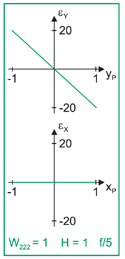Optipedia • SPIE Press books opened for your reference.
Astigmatism
Excerpt from Field Guide to Geometrical Optics
In a system with astigmatism, the power of the optical system in horizontal and vertical meridians is different as a function of image height.


With positive astigmatism, light from a vertical meridian is focused closer to the lens than light through the horizontal meridian. Each object point produces two perpendicular line images. These are the tangential focus and the sagittal focus. Sagittal focus is where the sagittal rays focus, and a line image in the meridional plane is formed. Tangential focus is where the tangential or meridional rays focus, and a line image is formed perpendicular to the meridional plane. Located between these two line foci is a circular focus called the medial focus.

Each of these foci lies on a separate curved image plane. In the presence of astigmatism only:
| Sagittal focus: | ΔW20 = 0 | δz = 0 |
| Medial focus: | ΔW20 = –.5W222H2 | δz≈ –4(f⁄#)2H2W222 |
| Tangential focus: | ΔW20 = –W222H2 | δz≈ –8(f⁄#)2H2W222 |
The field dependence of astigmatism is due to apparent foreshortening of the pupil at non-zero image heights. On axis, there is no astigmatism. This aberrational astigmatism is not caused by manufacturing errors.
J. E. Greivenkamp, Field Guide to Geometrical Optics, SPIE Press, Bellingham, WA (2004).
View SPIE terms of use.

